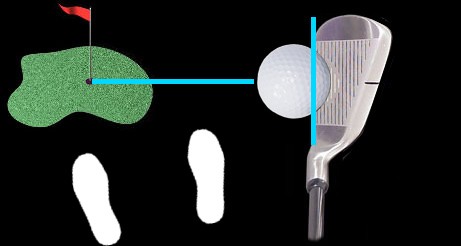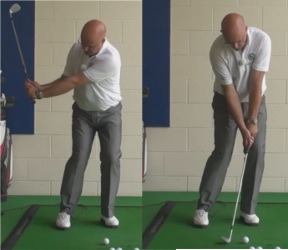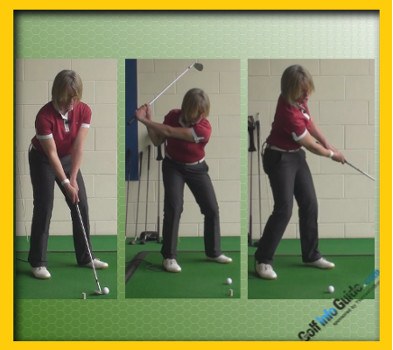
Phil Mickelson gets lots of “oohs” and “aahs” when he launches one of those famous, skyscraping pitch shots, aka the “flop shot.”
But a great flop shot is more than a show-stopping novelty. It's extremely handy in many greenside situations.
Anytime you've got to carry the ball over a hazard, dense rough or other obstacle to a pin that's tight against the trouble, the flop is the way to go. Your lie and the amount of green to work with dictate how high you need to hit it, but follow these steps to master the basics: 
- Use a lob wedge (at least 58° loft).
- Open your stance to the target line. The more open, the higher and shorter the ball will fly.
- Aim the clubface directly at the target, positioning the ball in the middle or slightly forward in your stance.
- Swing along the line of your body, making sure to accelerate through impact.
- Keep the clubface pointing skyward after contact. In other words, don't release (roll over) your forearms as you would on a normal shot.
Experiment with ball position and the amount you open your stance to control trajectory and distance.

How to Hit a Flop Shot
The flop shot is one of the hardest shots in golf. There is no point in hiding from that fact, so let's get it out of the way right from the start. If you are here looking for information on how to hit a successful flop shot, you should know from the beginning that this is a tough task. It is not impossible, but it is difficult. To pull off a great flop shot, you have to execute your technique just right – and you have to get a little lucky as well. While a flop shot is not something that you should be pulling out of your bag of tricks on a consistent basis, it is nice to have this option available when you find yourself in a tough spot around the green.
As you should already know, a flop shot is a short game shot which is played with a big swing and an open club face. The idea is simple – to hit the ball as high up into the air as possible while only covering a short horizontal distance. The shot is usually put to use when the player needs to stop the ball extremely quickly after it lands, usually on firm greens. By tossing the ball high into the sky, it will come down with very little forward momentum, leaving it nearly in place after landing. When executed correctly, it is a thing of beauty – and a highly effective play.
Of course, it can go wrong in a hurry. When not executed correctly, the results of a failed flop shot can easily lead to a double bogey or worse. There is a reason you rarely see your playing partners on the average public course try this kind of shot. It is tough to pull off, and it takes a steady nerve in addition to plenty of talent. Most of the time, when you see a flop shot used, it will be on TV when watching a professional golf tournament. Even the pros don't really like hitting flop shots, but they will resort to this play when there is no other good option available.
In this article, we are going to walk you through the basic steps required in order to produce a flop shot. Of course, if you are going to be at all comfortable with using this shot on the course, you will need to practice it consistently. Try to find a place to practice area where you can hit a few flop shots without any concern about hitting things (or people) around the green. A miss-hit flop shot can turn into a missile which shoots into the distance at high speed, so you want to make sure you have a safe area to learn this shot before you get started. The flop shot is never going to be the most reliable weapon in your short game arsenal, but it can save you a stroke or two from time to time when deployed correctly.
All of the instruction below is based on a right-handed golfer. If you play left-handed, please take a moment to reverse the directions as needed.

Finding the Right Time
Prior to talking about the technical details of how to hit a flop shot, we are first going to take a look at when you might decide to employ this play in your own game. As has been mentioned in the introduction, you don't want to use this kind of shot more than you have to, as it is always going to be a high-risk play, even for a talented golfer. As a general way of thinking, you always want to keep your short game shots as close to the ground as possible. When you miss the green, look for ways to play a bump-and-run style shot up to the hole. If that option is not realistic, start to look higher and higher until you find a path that you believe will work.
So when is the opportunity going to arise to use a flop shot? Look for the following situations as you play.
- Short shot over a bunker. When your ball comes to rest in a position where you need to play over a bunker to reach the green, you may want to pull out your flop shot to handle the job. This will only be necessary when the pin is cut just a few steps onto the green, of course, as a more forgiving hole location would likely allow you to play a lower shot and still stop the ball in time. Pulling out your flop shot in this situation is going to take a steady nerve, as coming up short of the target will mean leaving your ball in the bunker and causing yourself a major problem.
- Chip shot to a downslope. If the hole is located on a downslope and you are chipping from above the elevation of the green, a flop shot may be the only way to stop the ball reasonably quickly. The backspin you can get on a regular chip shot isn't going to do you much good when playing downhill, so lofting the ball high in the air could be your only choice. Before turning to this option, however, be sure to carefully review your lie. If the ball is also resting on a downslope, it might be too difficult to slide the club under the ball cleanly as will be necessary to hit a flop. If you have any doubts about the lie, play a standard chip and just accept the fact that you are going to have a long putt coming back for your par.
- Short sided to a firm green. A flop shot is going to be called for much more frequently when playing a course with firm greens. When the greens are soft, you don't have to worry about using this kind of shot often because your standard chip shots will stop quickly all on their own. When the greens dry out, on the other hand, you might find yourself consistently turning to the flop. It would be best to avoid short sided situations whenever possible, but even a smart golfer with a sound strategy is going to get out of position from time to time. When you do wind up in a short sided spot, consider opting for a flop shot to quickly bring the ball to rest even on hard greens.
- Pitch out of the deep rough. Playing from the deep rough is one of the times when a flop shot will actually be the best way to go. There isn't as much risk associated with flopping the ball from a deep lie, as there is going to be a little bit of air under the ball to make the task easier. In many ways, hitting a flop shot from the deep rough is like hitting a greenside bunker shot. Chipping with a lower-lofted club from long grass is hard because of the resistance provided by the grass – reach for your lob wedge and flop the ball up and out of the rough when you need to conquer a challenging lie.
You will need to be smart with your shot selection around the greens once you have the flop shot in your bag. It is tempting to turn to this shot more than necessary just because it looks so impressive. Sure, you might be able to impress your friends by firing the ball high into the air, but it is only the results of the shot that matter in the end. Default to other choices and only lean in this direction when you feel like it is the best option, and when you have a lie good enough to pull it off.

The Technique
At this point, we are going to get down to the business of outlining the proper technique to hit a flop shot. As you might expect, you will have to change your technique dramatically from what you would use for a normal chip shot if you are going to hit a flop way up into the air. In fact, the flop shot technique has more in common with your full swing than it does with your chipping.
Without further delay, let's get right down to business on outlining the proper technique for a great flop shot. Use the points below as your guide.
- Use your most-lofted club. This might be an obvious point, but you need to pull your most-lofted club from the bag when you are going to hit a flop. That might be a 58* wedge, or it may be a 60*. Whatever you happen to carry in the wedge department, use as much loft as you have available for this type of shot.
- Keep your hands on the end of the grip. You are probably used to choking down on the grip of the club when hitting a shot from around the green. That is a good idea for most shots, but not for a flop. When you want to hit the ball high in the air, you need as much speed as you can create – meaning you need to keep your hands all the way up on the end of the grip.
- Open your stance, and place your feet far apart. You will want to use an extremely wide stance for your flop shots, and you will want to open your feet in relation to the target line. The open stance is important because you need to swing across the ball in order to get it to pop up into the air nicely. Make sure your feet are considerably farther apart than shoulder width, and set your left foot much farther from the target line than your right. Not only will the open stance help you to swing across the ball, it will also give you a good look at the target as you prepare to hit the shot.
- Make a full backswing. Yes, even though you may only be a few yards from the target, you still need to make a full backswing. Take the club all the way up to the top, just as you would when hitting an iron shot from back in the fairway. You don't want to make this backswing with just your arms, either – swing back by making a good shoulder turn and prepare yourself for an aggressive downswing.
- Release the club fully with the right hand. This may be the most important tip in the entire article. As the club approaches the hitting area, you need to fire through with your right-hand in order to maximize both speed and loft. Using an aggressive right hand release will throw the club head under the ball, adding a lot of spin to the shot and sending the ball way up into the sky. Without question, this is going to be the hardest part of the shot to learn. You will likely be hesitant to use a full release on such a short shot. Only through consistent practice will you be able to learn how to trust this bold technique.
- Keep your eyes down after the ball is gone. You already know that you need to keep your eyes down when hitting golf shots, but this is especially important on a flop shot. If you look up at all, even slightly, before you hit the shot, you are very likely to hit it thin. What happens to a thin flop shot? It becomes a rocket, shooting quickly across the green and into the distance. Most likely, this kind of shot will not come to rest before it leaves the golf course. As you learn how to play flop shots, teach yourself to keep your eyes down through impact and beyond – you should be looking at an empty patch of grass after you hit the shot.
Hitting flop shots is not easy. Many of your flop shots are going to fail, especially early in the learning process. When you struggle, return to the list above to get yourself back on track. It will take plenty of practice time before you have enough confidence in this shot to pull it out on the course. When you do decide to use it, however, it just might save you a stroke or two in a key situation.

Potential Problems
There is a lot that can go wrong when trying to hit a flop shot. While you don't really want to focus on the negative side of this shot, you also need to be aware of what can happen so you can pick the right times to use the flop. The list below includes a number of ways in which a flop shot can go wrong.
- Hitting the shot thin. We mentioned this error above, but it gets another mention here because of just how serious this mistake can be. You are probably going to lose two strokes on your scorecard by hitting a flop shot thin, and the damage may be even worse. This is probably the worst outcome of all, so you should do what you can to avoid making this brutal mistake.
- Hitting the shot fat. On the other end of the spectrum, a fat flop shot isn't a lot of fun either. While not as damaging as a thin shot, hitting this kind of shot fat is going to cause you to leave the ball well short of the target. In fact, the ball might only move a couple of feet from where it started. If you were using a flop shot because you needed to get the ball up and over some kind of hazard, you may now find your ball at the bottom of that hazard.
- Hitting a shank. Since you are opening the face of the club dramatically when hitting a flop shot, you will run the risk of hitting a shank. The hosel is going to be exposed to the ball on the way through impact, and you may be playing from a lie which is less-than-ideal. A shanked flop shot will react in much the same way as a thin one, meaning you are certainly going to use some extra shots trying to recover from this kind of error.
- Going under the ball. One of the challenges with hitting a flop shot is the fact that you can make a good swing and still wind up with a poor shot. Usually, this happens when the ball is sitting up off the ground, suspended by the surrounding grass. The club will slide right under the ball, you will barely make contact at all, and the ball will move only inches forward – if it moves at all. This is different than a fat shot in that you haven't made a poor swing, but the result will be almost exactly the same.
This list might be a little depressing, in the fact that it highlights just how much can go wrong with a flop shot. However, it is good to go over this list since it will bring a dose of reality to the process. Sure, a flop shot can help you out in a tough spot, but they are more trouble than they are worth most of the time. Always keep these dangers in mind when trying to decide which shot you are going to use.

Having the Right Attitude
A big part of your success or failure with a flop shot is going to come down to the way you think about the shot. Of course, the same can be said for most of the game of golf, as you always need to have a good attitude no matter what shot you are trying to hit. As it relates specifically to the flop shot, you need to start out in a positive frame of mind. Yes, this is a hard shot. And yes, there is a lot that can go wrong. But if you are thinking about those negative things while making your swing, it will be nearly impossible to succeed. Once you have decided that the flop shot is the way to go, put any negativity to the side and just focus in on making a great swing.
Also, when hitting a flop shot, you need to think about being aggressive. The flop shot is not a shot you can play by gently swinging the club into the ball and hoping for the best. You have to be fully committed to the shot, and you have to make an aggressive swing all the way through impact. Without that aggressiveness, you have almost no chance to pull off the shot properly. If you can't convince yourself to be aggressive with the flop shot on the course, you might as well decide to play the shot a different way.
The last piece of the attitude puzzle is accepting the fact that this shot might not come off exactly as you planned. You know going into the shot that it is a risk, so accept that risk and be okay with the outcome. Some of your flop shots are going to come off perfectly, and some will be failures. That's okay. There is no shame in having a flop shot or two miss the target, as long as some of them work beautifully.
As has been mentioned throughout this article, the flop shot is a tough part of this game. Even professionals have trouble hitting a quality flop, and many never do manage to learn how to play this shot correctly. If you are hoping to add the flop shot to your game, get ready for a challenge and be aware that you aren't going to be 100% successful. However, with all of that said, this is still a helpful shot to have somewhere in your bag when the moment arises. Should you find your ball in a tough spot where only a high lob will do, the flop shot can suddenly become your best friend. Good luck!






